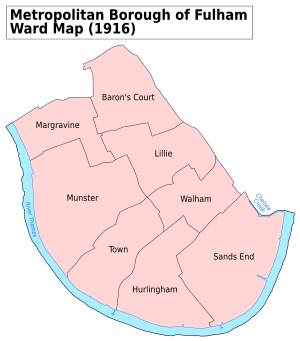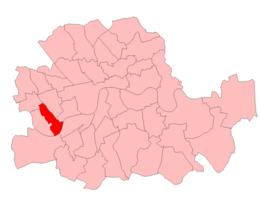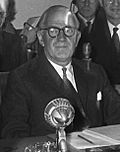Quick facts for kids {{{Name}}}
[[{{{Type}}} constituency]] |
[[Image:{{{Map1}}}Constituency.svg|120px|]]
[[Image:England{{{Map2}}}.svg|120px|]] |
| {{{Name}}} shown within [[{{{Entity}}}]], and {{{Entity}}} shown within England |
| Created: |
{{{Year}}} |
| MP: |
{{{MP}}} |
| Party: |
{{{Party}}} |
| Type: |
House of Commons |
| County: |
[[{{{County}}}]] |
| EP constituency: |
[[{{{EP}}} (European Parliament constituency)|{{{EP}}}]] |
Fulham East was a borough constituency in the Metropolitan Borough of Fulham in London. It was represented in the House of Commons of the Parliament of the United Kingdom from 1918 to 1955. Elections were held using the first-past-the-post voting system.

Fulham East in the County of London, boundaries 1918-50

A map showing the wards of Fulham Metropolitan Borough as they appeared in 1916.

Fulham East in the County of London, boundaries 1950-55
At the 1918 general election the previous Fulham constituency was divided into two constituencies, Fulham East and Fulham West; the two halves were re-united for the 1955 general election. At the 1997 general election, the Fulham constituency was replaced by Hammersmith and Fulham.
Boundaries
The Metropolitan Borough of Fulham wards of Barons Court, Lillie, Sands End, and Walham.
Members of Parliament
Election results
Election in the 1910s
Election in the 1920s
| General election 1929: Fulham East |
| Party |
Candidate |
Votes |
% |
±% |
|
Unionist |
Kenyon Vaughan-Morgan |
15,130 |
44.3 |
−17.3 |
|
Labour |
John Palmer |
13,425 |
39.4 |
+1.0 |
|
Liberal |
John Henry Greenwood |
5,551 |
16.3 |
New |
| Majority |
1,705 |
4.9 |
−18.3 |
| Turnout |
34,106 |
66.8 |
−2.3 |
| Registered electors |
51,066 |
|
|
|
Unionist hold |
Swing |
−9.2 |
|
Election in the 1930s
| General election 1931: Fulham East |
| Party |
Candidate |
Votes |
% |
±% |
|
Conservative |
Kenyon Vaughan-Morgan |
23,438 |
68.7 |
+14.4 |
|
Labour |
John Maynard |
8,917 |
26.1 |
-13.3 |
|
Liberal |
John Henry Greenwood |
1,788 |
5.2 |
-11.1 |
| Majority |
14,521 |
42.6 |
+37.7 |
| Turnout |
34,143 |
66.1 |
-0.5 |
|
Conservative hold |
Swing |
|
|
| 1933 Fulham East by-election |
| Party |
Candidate |
Votes |
% |
±% |
|
Labour |
John Wilmot |
17,790 |
57.9 |
+31.8 |
|
Conservative |
William James Waldron |
12,950 |
42.1 |
-26.6 |
| Majority |
4,840 |
15.8 |
N/A |
| Turnout |
30,740 |
59.5 |
-7.6 |
|
Labour gain from Conservative |
Swing |
+29.2 |
|
Election in the 1940s
Elections in the 1950s
| General election 1951: Fulham East |
| Party |
Candidate |
Votes |
% |
±% |
|
Labour |
Michael Stewart |
20,279 |
53.2 |
+3.1 |
|
Conservative |
John Hall |
17,806 |
46.8 |
+3.9 |
| Majority |
2,473 |
6.4 |
-0.8 |
| Turnout |
38,085 |
84.5 |
+0.3 |
|
Labour hold |
Swing |
|
|





